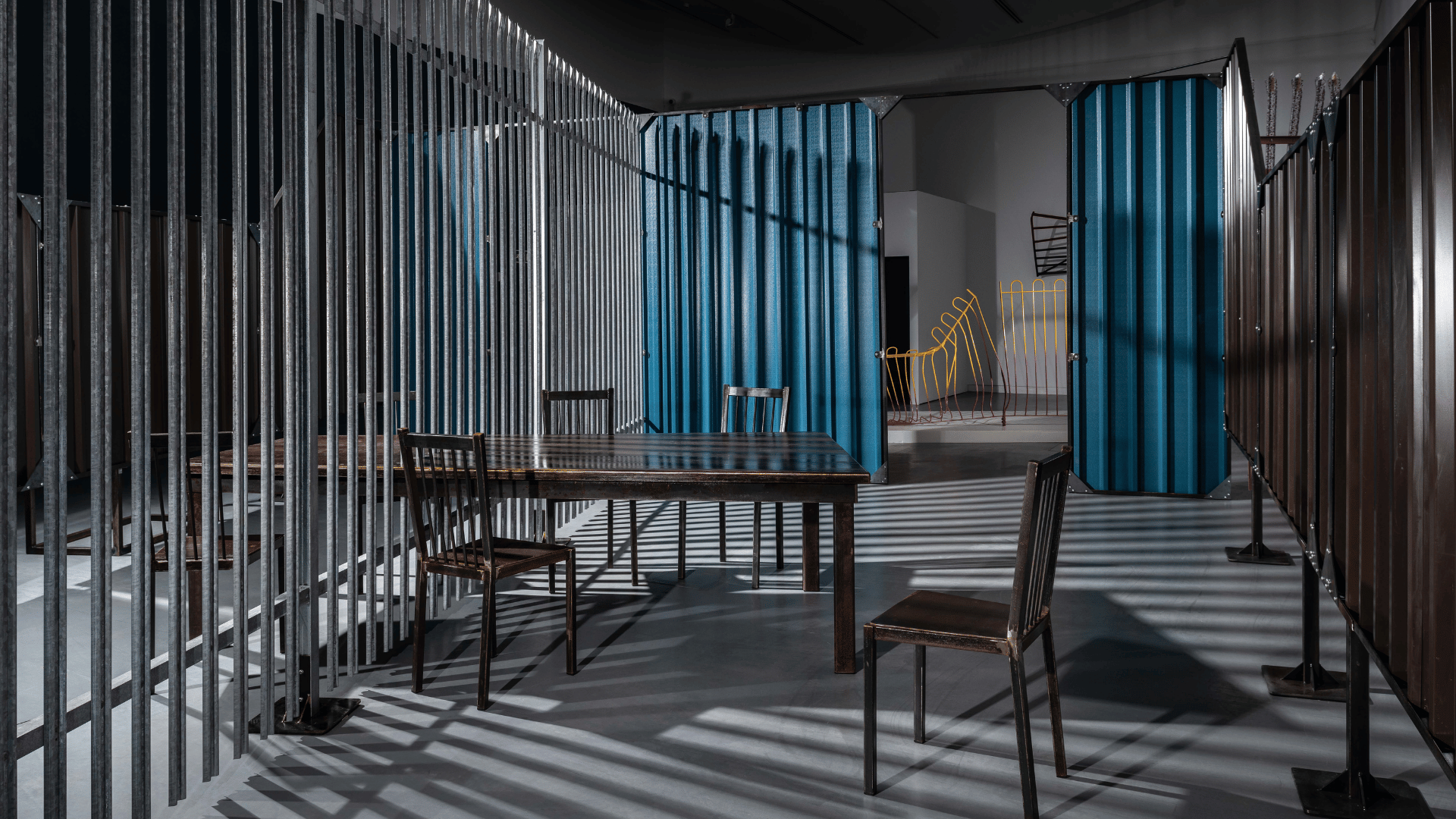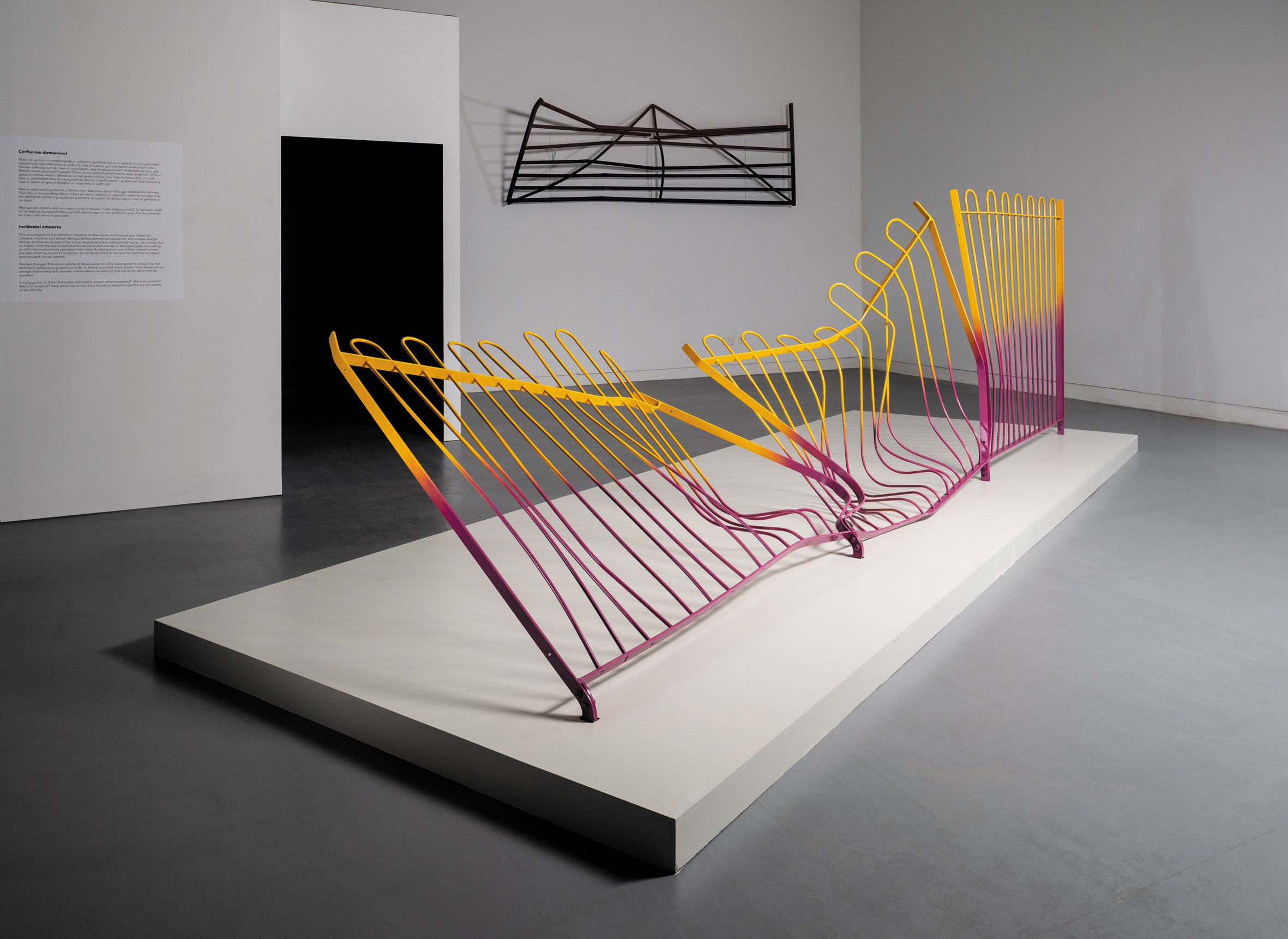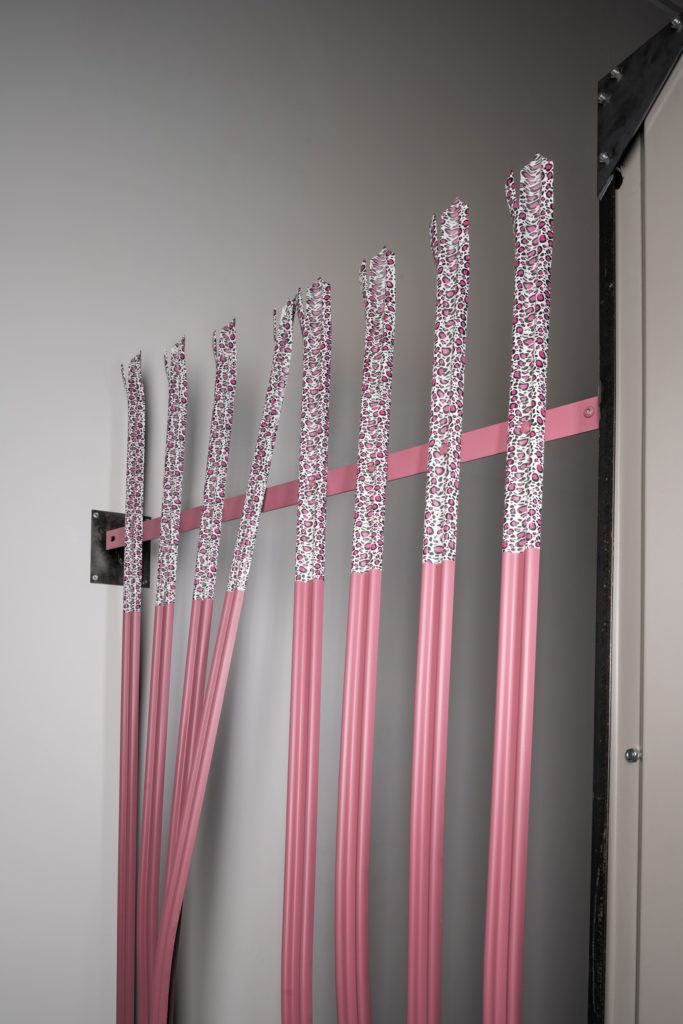Review: IMPACT/Ardrawiad by Angharad Pearce Jones, Aberystwyth Arts Centre

Niall Griffiths
This is powerful stuff; angry, thoughtful, hugely skilled. Whether you enter through the left door or the right door isn’t really particularly relevant, as the agency of your choice will be removed by the starkness of the space you find yourself in, the incarceral nature of it; a table divided by tall, steel trident-topped railings, four chairs on one side and two on the other, steel walls (from shipping containers, it seems), institutional colours of grey, pale blue, brown, all is hard wood and iron and steel.
There’s a creeping feeling of sadness. It’s on a much, much smaller scale, of course (being in an art gallery and not a big city), but I’m nevertheless reminded of Eisenman and Happold’s Holocaust Memorial in Berlin; there’s a similar sense, differing only in degree, of alienation, loss, distance, even creeping panic; this is a place for interrogation and isolation and the threat of humiliation.
This divided table will, if we let it, morph into the huge and inhuman stelae of Happold and Eisenman’s terrifying vision. Strung across the top of the steel wall to the right are some little twinkling lights which suggest a begrudging and paltry recognition of an Othered person’s humanity; Robert Jenrick, I imagine, would have those lights torn down in an anxiety-accelerated heartbeat. Soul-less husk of a man that he is.
This is one half of Angharad Pearce Jones’s IMPACT exhibition. It’s her largest solo show to date. She’s been a worker in steel, that quintessential Welsh valleys substance (alongside coal), for 30 years; she is intrigued by its associations with division, imprisonment and also protection, its suggested ‘aesthetics of the edge of town, industrial estate’.
She’s been a commercial blacksmith and metal fabricator and has ‘created hundreds of straight panels, leading to a fascination with imperfect ones’ (all quotes from website and wall-mounted informational/background bumf), which preoccupation informs the second part of the exhibit, the found objects thrown up by ‘5 years documenting damaged gates and railings’.
These are quasi-sculptural works, lifted from Jones’s local area and thus of personal significance to her ‘as they are all from places she frequents during her daily life as a metalworker and a Mother’; they are embodiments of the friability of metal (and therefore a contrast with the bulwark steel of the exhibition’s first section, through which you must move to reach part 2), of its capacity to ‘collapse, implode and distort due to impact’.
Taken from their original physical contexts and displayed in this way – on plinths, platforms, wall-brackets – they become both loquacious and implicit; their buckling and bending suggests violence and trauma but also the breaking of barriers: number 5, for instance, is the gaping section of railings that children would squeeze through at Brynaman Primary School, and number 9 is the concealed gap that youngsters would use to gain access, without paying, to the Pure Football Sports Complex in Llangyfelach.

The particular impact here, then, this warping of steel, came from the human desire to break barriers down; that is, to create more freedoms.
Number 6 is formed of the broken gate adjacent to the now iconic Cofiwch Dryweryn graffito outside Llanrhystud in Ceredigion; number 7 is the listing cemetery gates of Hen Fethel Capel in Garnant (and what twisted them so? One of us trying to get in, or one of them trying to get out?).
And the lighting is expertly done, with the clear and web-like shadows thrown onto walls and floor; there’s a beauty to this, and a confusion between the insubstantiality of shadow and the bold black fixed strokes of it (I can imagine the words ACCESS DENIED written on a form in such solid strokes).

Colour
And then there’s the colour which the artist has applied to these objects: the technique is called aquagraphics, I learnt (every day’s a schoolday), and it involves immersing the object in liquid film to create hues of a ‘sickly sweet colour palette inspired by fairgrounds and play parks’ and aiming to provoke in us, apparently, the appalled fascination we have with accidents, misfortunes that happen to other people.
This last issue I’m not sure about; the garishness of the colours work on me not as aposematic but as allure; they, at least initially, override the background sense of calamity, like a lei draped over a coffin.
But if it’s a truism that disturbed and divided times produce the best art, then this exhibition reinforces that. It is thrilling and vivid and alive. You can see it in Aberystwyth Arts Centre until February of next year. You’ll be rewarded if you do.
IMPACTArdrawiad is at Canolfan y Celfyddydau/Abertwyth Arts Centre until the 11th February 2024. The book of the same name is published by the H’mm Foundation and is available from all good bookshops.
Support our Nation today
For the price of a cup of coffee a month you can help us create an independent, not-for-profit, national news service for the people of Wales, by the people of Wales.






